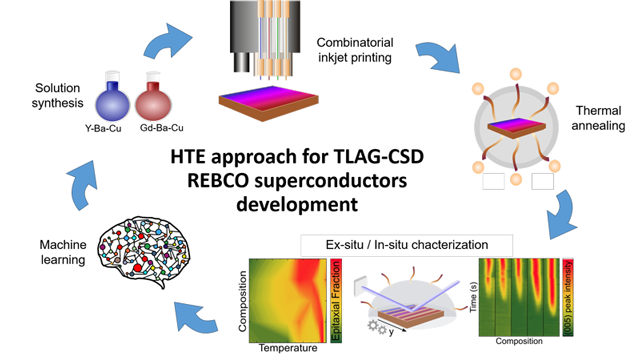PC12-5
Exploring TLAG-CSD REBCO Superconductors Optimization by High-Throughput Experimentation and Machine Learning
*Albert Queraltó1, Juri Banchewski1, Kapil Gupta1, Adrià Pacheco1, Lavinia Saltarelli1, Diana Garcia1, Cristian Mocuta2, Susagna Ricart1, Xavier Obradors1, Teresa Puig1
- Institut de Ciència de Materials de Barcelona (ICMAB-CSIC), Campus UAB, 08193 Bellaterra, Catalonia, Spain1
- Synchrotron SOLEIL, L’Orme des Merisiers Saint-Aubin BP 48, 91192 Gif-sur-Yvette, France2
High-throughput materials development (HTMD) has already demonstrated its potential to enable an accelerated discovery, advance and optimization of materials by fabricating and characterizing samples with different compositions using physical or chemical deposition methods. Drop-on-demand inkjet printing (DoD IJP) is an ideal chemical solution deposition (CSD) technique to produce high-throughput complex samples of locally-uniform or graded compositions, providing high spatial resolution for parallel investigations on morphological, structural and functional properties. In addition, machine learning (ML) is being increasingly used in recent years, as an alternative tool to conventional trial-and-error materials design to find hidden patterns within computational and experimental data aiming to fasten the optimization and discovery of materials and processes. Altogether, it enables the development of new high-throughput data-driven (HTDD) strategies that combine both HTMD and ML.
In this work, we present our HTDD approach to speed up the optimization and fabrication of REBCO superconducting films through the innovative transient-liquid assisted growth (TLAG) CSD process [1,2], which can reach growth rates above 100 nm/s. Compositional gradient films were deposited by mixing cuprate precursor chemical solutions with DoD IJP, enabling the exploration of rare-earth and liquid phase compositional changes on epitaxial growth. Machine learning was employed to optimize deposition and pyrolysis parameters to achieve a homogeneous merging of precursor inks and optimum surface morphology, as confirmed by EDX and high-resolution XRD. Afterwards, epitaxial growth studies of the pyrolyzed samples enabled the fast identification of optimal processing conditions ranges for different compositions. In-situ XRD synchrotron radiation experiments were employed to perform one-step fast analysis of different compositions and determination of growth rates [3]. This knowledge was finally used in our HTDD approach to find patterns in the epitaxial growth characteristics.
References:
[1] Soler et al. Nat. Comm. 11, 344 (2020).
[2] Rasi et al. J. Phys. Chem. C 124, 15574-15584 (2020).
[3] Queraltó et al. ACS Appl. Mater. Interfaces, 13, 9101 (2021).
Keywords: Combinatorial chemistry, High-throughput experimentation, Superconducting materials, Machine learning
